A) 0.06-m line
B) 0.24-m line
C) 0.56-m line
D) 0.71-m line
E) A 5.0-kg object cannot be placed anywhere on the meter stick to result in equilibrium in this system.
Correct Answer

verified
Correct Answer
verified
Multiple Choice
A spinning skater draws in her outstretched arms thereby reducing her moment of inertia by a factor of 2.Determine the ratio of her final kinetic energy to her initial kinetic energy.
A) 0.5
B) 1
C) 2
D) 4
E) 16
Correct Answer

verified
Correct Answer
verified
Multiple Choice
A hollow cylinder of mass M and radius R rolls down an inclined plane.A block of mass M easily slides down an identical inclined plane.Complete the following statement: If both objects are released at the same time from the top of their inclined planes,
A) the cylinder will reach the bottom first.
B) the block will reach the bottom first.
C) the block will reach the bottom with the greater kinetic energy.
D) the cylinder will reach the bottom with the greater kinetic energy.
E) both the block and the cylinder will reach the bottom at the same time.
Correct Answer

verified
Correct Answer
verified
Multiple Choice
A child standing on the edge of a freely spinning merry-go-round moves quickly to the center.Which one of the following statements is necessarily true concerning this event and why?
A) The angular speed of the system decreases because the moment of inertia of the system has increased.
B) The angular speed of the system increases because the moment of inertia of the system has increased.
C) The angular speed of the system decreases because the moment of inertia of the system has decreased.
D) The angular speed of the system increases because the moment of inertia of the system has decreased.
E) The angular speed of the system remains the same because the net torque on the merry-go-round is zero N . m.
Correct Answer

verified
Correct Answer
verified
Multiple Choice
A solid cylinder of radius 0.35 m is released from rest from a height of 1.8 m and rolls down the incline as shown.What is the angular speed of the cylinder when it reaches the horizontal surface? 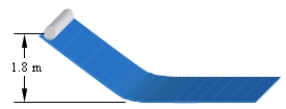
A) 8.2 rad/s
B) 14 rad/s
C) 34 rad/s
D) 67 rad/s
E) This cannot be determined because the mass is unknown.
Correct Answer

verified
Correct Answer
verified
Multiple Choice
A solid sphere rolls without slipping along a horizontal surface.What percentage of its total kinetic energy is rotational kinetic energy?
A) 33 %
B) 50 %
C) 12 %
D) 75 %
E) 29 %
Correct Answer

verified
E
Correct Answer
verified
Multiple Choice
Consider the following four objects: a hoop, a flat disk, a solid sphere, and a hollow sphere.Each of the objects has mass M and radius R.The axis of rotation passes through the center of each object, and is perpendicular to the plane of the hoop and the plane of the flat disk.Which of these objects requires the largest torque to give it the same angular acceleration?
A) the solid sphere
B) the hollow sphere
C) the hoop
D) the flat disk
E) both the solid and the hollow spheres
Correct Answer

verified
Correct Answer
verified
Multiple Choice
A ceiling fan has five blades, each with a mass of 0.34 kg and a length of 0.66 m.The fan is operating in its "low" setting at which the angular speed is 9.4 rad/s.If the blades can be approximated as uniform thin rods that rotate about one end, what is the total rotational kinetic energy of the five blades?
A) 35 J
B) 29 J
C) 23 J
D) 17 J
E) 11 J
Correct Answer

verified
E
Correct Answer
verified
Multiple Choice
A solid sphere and a hollow sphere each of mass M and radius R are released at the same time from the top of an inclined plane.Which one of the following statements is necessarily true?
A) The solid sphere will reach the bottom first.
B) The hollow sphere will reach the bottom first.
C) Both spheres will reach the bottom at the same time.
D) The solid sphere will reach the bottom with the greater kinetic energy.
E) The hollow sphere will reach the bottom with the greater kinetic energy.
Correct Answer

verified
Correct Answer
verified
Multiple Choice
A ball of mass M moves in a circular path on a horizontal, frictionless surface.It is attached to a light string that passes through a hole in the center of the table.If the string is pulled down, thereby reducing the radius of the path of the ball, the speed of the ball is observed to increase.Complete the following sentence: This occurs because 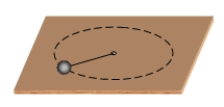
A) the linear momentum of the ball is conserved.
B) it is required by Newton's first law of motion.
C) the angular momentum of the ball is conserved.
D) the angular momentum of the ball must increase.
E) the total mechanical energy of the ball must remain constant.
Correct Answer

verified
Correct Answer
verified
Multiple Choice
An 80-kg man balances the boy on a teeter-totter as shown.Note: Ignore the weight of the board. 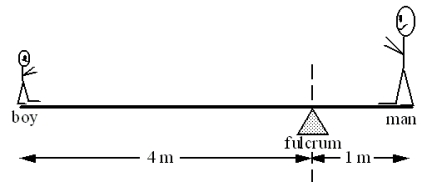 -Which one of the following statements most accurately describes the center of gravity of an object?
-Which one of the following statements most accurately describes the center of gravity of an object?
A) It is the point where gravity acts on the object.
B) It is the point where all the mass is concentrated.
C) It must be experimentally determined for all objects.
D) It is the point on the object where all the weight is concentrated.
E) It is the point from which the torque produced by the weight of the object can be calculated.
Correct Answer

verified
Correct Answer
verified
Multiple Choice
A 1500-kg satellite orbits a planet in a circular orbit of radius 6.2 × 106 m.What is the angular momentum of the satellite in its orbit around the planet if the satellite completes one orbit every 1.5 × 104 s?
A) 3.9 × 106 kg .m2/s
B) 1.4 × 1014 kg .m2/s
C) 6.2 × 108 kg .m2/s
D) 8.1 × 1011 kg .m2/s
E) 2.4 × 1013 kg .m2/s
Correct Answer

verified
Correct Answer
verified
Multiple Choice
A steady horizontal force  of magnitude 21 N is applied at the axle of a solid disk as shown.The disk has mass 2.0 kg and diameter 0.10 m.What is the linear speed of the center of the disk after it has moved 12 m?
of magnitude 21 N is applied at the axle of a solid disk as shown.The disk has mass 2.0 kg and diameter 0.10 m.What is the linear speed of the center of the disk after it has moved 12 m? 
A) 9.0 m/s
B) 13 m/s
C) 16 m/s
D) 22 m/s
E) 44 m/s
Correct Answer

verified
Correct Answer
verified
Multiple Choice
Planets A and B are uniform solid spheres that rotate at a constant speed about axes through their centers.Although B has twice the mass and three times the radius of A, each planet has the same rotational kinetic energy.What is the ratio B/ A of their angular speeds?
A) 0.055
B) 0.093
C) 0.165
D) 0.191
E) 0.236
Correct Answer

verified
Correct Answer
verified
Multiple Choice
Two skaters, each of mass 40 kg, approach each other along parallel paths that are separated by a distance of 2 m.Both skaters have a speed of 10 m/s.The first skater carries a 2-m pole that may be considered massless.As he passes the pole, the second skater catches hold of the end.The two skaters then go around in a circle about the center of the pole. 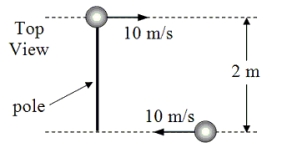 -What is the angular speed of the skaters after they have linked together?
-What is the angular speed of the skaters after they have linked together?
A) 4 rad/s
B) 5 rad/s
C) 10 rad/s
D) 20 rad/s
E) 40 rad/s
Correct Answer

verified
Correct Answer
verified
Multiple Choice
A 60.0-kg skater begins a spin with an angular speed of 6.0 rad/s.By changing the position of her arms, the skater decreases her moment of inertia to one-half its initial value.What is the skater's final angular speed?
A) 3.0 rad/s
B) 4.5 rad/s
C) 9.0 rad/s
D) 12 rad/s
E) 18 rad/s
Correct Answer

verified
Correct Answer
verified
Multiple Choice
Two equal spheres, labeled A and B in the figure, are attached to a massless rod with a frictionless pivot at the point P.The system is made to rotate clockwise with angular speed on a horizontal, frictionless tabletop.Sphere A collides with and sticks to another equal sphere that is at rest on the tabletop.Note: the masses of all three spheres are equal. What is the angular speed of the system immediately after the collision? 
A) ( )
B) 0.82
C) 0.60
D) 0.56
E) 0.29
Correct Answer

verified
Correct Answer
verified
Multiple Choice
One end of a rope is tied to the handle of a horizontally-oriented and uniform door.A force  is applied to the other end of the rope as shown in the drawing.The door has a weight of 145 N and is hinged on the right.What is the maximum magnitude of
is applied to the other end of the rope as shown in the drawing.The door has a weight of 145 N and is hinged on the right.What is the maximum magnitude of  for which the door will remain at rest?
for which the door will remain at rest? 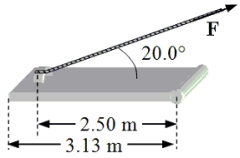
A) 145 N
B) 265 N
C) 381 N
D) 424 N
E) 530 N
Correct Answer

verified
B
Correct Answer
verified
Multiple Choice
A 4.0-kg ball moves in a straight line at 8.0 m/s as shown in the figure.At the instant shown, what is its angular momentum about the point P? 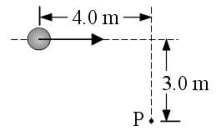
A) 33 kg . m2/s
B) 85 kg. m2/s
C) 110 kg .m2/s
D) 160 kg . m2/s
E) zero kg . m2/s
Correct Answer

verified
Correct Answer
verified
Multiple Choice
What happens when a spinning ice skater draws in her outstretched arms?
A) Her angular momentum decreases.
B) Her angular momentum increases.
C) Her moment of inertia decreases causing her to speed up.
D) Her moment of inertia decreases causing her to slow down.
E) The torque that she exerts increases her moment of inertia.
Correct Answer

verified
Correct Answer
verified
Showing 1 - 20 of 57
Related Exams